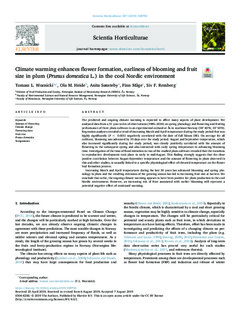| dc.contributor.author | Woznicki, Tomasz | |
| dc.contributor.author | Heide, Ola M | |
| dc.contributor.author | Sønsteby, Anita | |
| dc.contributor.author | Måge, Finn | |
| dc.contributor.author | Remberg, Siv Fagertun | |
| dc.date.accessioned | 2020-01-03T13:09:37Z | |
| dc.date.available | 2020-01-03T13:09:37Z | |
| dc.date.created | 2019-08-13T12:31:41Z | |
| dc.date.issued | 2019 | |
| dc.identifier.citation | Scientia Horticulturae. 2019, 257 . | nb_NO |
| dc.identifier.issn | 0304-4238 | |
| dc.identifier.uri | http://hdl.handle.net/11250/2634823 | |
| dc.description.abstract | The predicted and ongoing climate warming is expected to affect many aspects of plant development. We analysed data from a 31-year series of observations (1985–2016) on spring phenology and flowering and fruiting performance of three plum cultivars in an experimental orchard at Ås in southeast Norway (59° 40′N; 10° 50′E). Regression analyses revealed a trend of increasing March and April temperature during the study period that was highly significantly (P < 0.001) negatively correlated with the date of full bloom (FB). On average for all cultivars, blooming was advanced by 10 days over the study period. August and September temperature, which also increased significantly during the study period, was closely positively correlated with the amount of flowering in the subsequent spring and also interacted with early spring temperature in advancing blooming time. Investigation of the time of floral initiation in two of the studied plum cultivars revealed that the transition to reproductive development took place in early to mid-August. This finding strongly suggests that the close positive correlation between August-September temperature and the amount of flowering in plum observed in this and other studies, is causally linked to a specific physiological effect of elevated temperature on the flower bud formation process. Increasing March and April temperatures during the last 30 years has advanced blooming and spring phenology in plum and the resulting extension of the growing season has led to increasing fruit size at harvest. We conclude that so far, the ongoing climate warming appears to have been positive for plum production in the cool Nordic environment. However, an increasing risk of frost associated with earlier blooming will represent a potential negative effect of continued warming. | nb_NO |
| dc.language.iso | eng | nb_NO |
| dc.rights | Attribution-NonCommercial-NoDerivatives 4.0 Internasjonal | * |
| dc.rights.uri | http://creativecommons.org/licenses/by-nc-nd/4.0/deed.no | * |
| dc.title | Climate warming enhances flower formation, earliness of blooming and fruit size in plum (Prunus domestica L.) in the cool Nordic environment | nb_NO |
| dc.title.alternative | Climate warming enhances flower formation, earliness of blooming and fruit size in plum (Prunus domestica L.) in the cool Nordic environment | nb_NO |
| dc.type | Journal article | nb_NO |
| dc.type | Peer reviewed | nb_NO |
| dc.description.version | publishedVersion | nb_NO |
| dc.source.pagenumber | 7 | nb_NO |
| dc.source.volume | 257 | nb_NO |
| dc.source.journal | Scientia Horticulturae | nb_NO |
| dc.identifier.doi | 10.1016/j.scienta.2019.108750 | |
| dc.identifier.cristin | 1715563 | |
| cristin.unitcode | 192,14,0,0 | |
| cristin.unitcode | 192,10,2,0 | |
| cristin.unitname | Miljøvitenskap og naturforvaltning | |
| cristin.unitname | Institutt for plantevitenskap | |
| cristin.ispublished | true | |
| cristin.fulltext | original | |
| cristin.qualitycode | 1 | |

